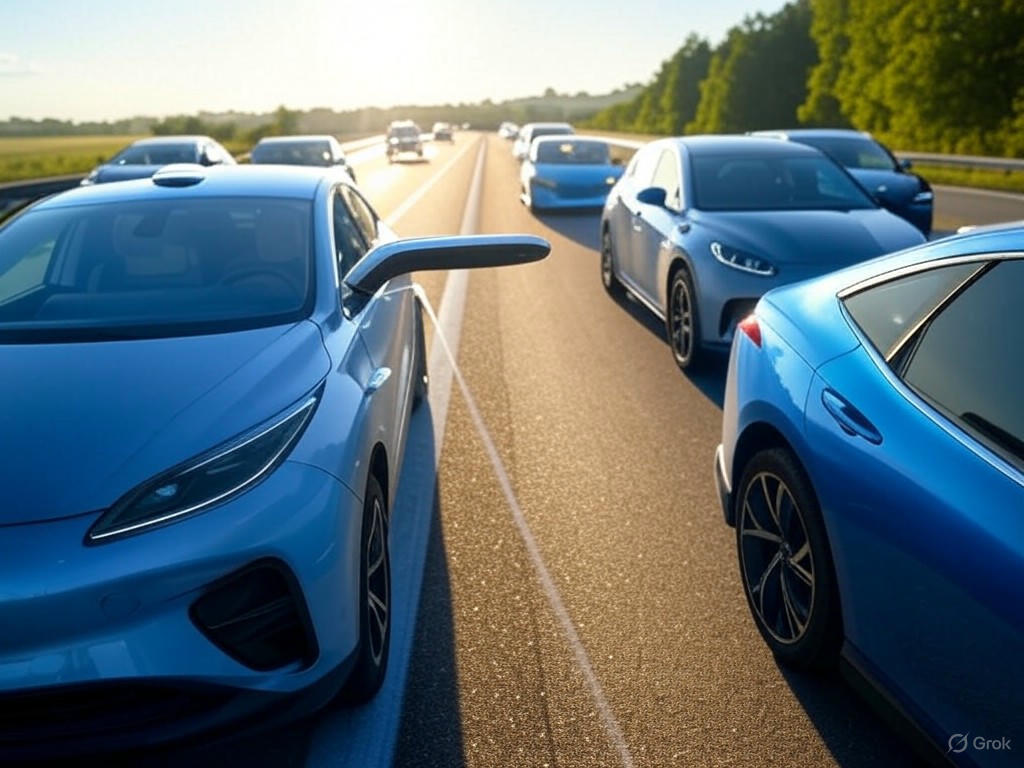
Self-Driving Cars Communicate via AI Social Network
The Dawn of AI Social Network in Autonomous Vehicles
In the rapidly evolving world of autonomous technology, self-driving cars are now part of an innovative AI social network that lets them share vital information instantly. This breakthrough, powered by Cached Decentralized Federated Learning (Cached-DFL), allows vehicles to exchange data without a central server, boosting both security and performance on the roads. Imagine a fleet of cars learning from each other in real time, much like friends swapping tips during a road trip—what could make driving safer and smarter?
Unlike older models that navigate solo, these connected self-driving cars tap into an AI social network to relay details about traffic, weather, or sudden obstacles. This shift not only enhances vehicle-to-vehicle communication but also paves the way for a more adaptive transportation system. As cities grow busier, relying on this AI social network could mean fewer accidents and smoother journeys for everyone.
How the AI Social Network Works for Vehicles
The AI social network mimics human interactions, where knowledge spreads quickly through a digital web of connected devices. Researchers at NYU Tandon’s Electrical and Computer Engineering Department created Cached-DFL to let vehicles learn from one another, even if they’re not in direct contact. This means a car in one neighborhood can benefit from experiences shared across the entire network, making the system incredibly efficient.
In this setup, vehicles train their AI models using local data and exchange them when they’re close—around 100 meters apart. They don’t send raw data, which keeps things private and fast. Key features include independent model training, direct sharing during proximity, efficient knowledge transfer, and relaying information from other vehicles they’ve encountered. Have you ever wondered how a single car’s experience could help thousands of others avoid a pothole?
- Train AI models based on immediate surroundings
- Exchange models during brief encounters
- Share insights without overloading networks
- Pass along data like a chain of whispers
Professor Yong Liu describes it as information flowing like a social network, where indirect connections still deliver value. This AI social network isn’t just tech—it’s a collaborative ecosystem that evolves with every interaction.
Digital Word-of-Mouth in the AI Social Network
Think of this as digital word-of-mouth accelerating how self-driving cars adapt and learn. Cached-DFL tackles the big challenge of collective intelligence while protecting privacy and security. For instance, a vehicle that’s only driven in suburban areas could gain insights about city traffic through the AI social network, preparing it for unfamiliar challenges.
Professor Liu gives a relatable example: a car familiar with Manhattan streets might never visit Brooklyn, but through the AI social network, it absorbs knowledge from others that have. This transforms individual cars into part of a smarter, unified system. Isn’t it fascinating how this setup lets vehicles evolve collectively, much like how we learn from our social circles?
By focusing on shared models rather than raw data, the AI social network ensures rapid improvements without compromising user privacy. This approach could redefine autonomous driving, turning isolated trips into connected adventures.
Enhanced Safety Through the AI Social Network
Safety takes center stage with this AI social network, as self-driving cars share critical updates on road conditions and hazards in real time. This collective intelligence helps vehicles anticipate problems, like a sudden traffic jam or icy patches, long before they arrive. In busy urban settings, where surprises are common, this network could be a game-changer.
For example, if one car detects a road closure, that alert spreads through the AI social network, allowing others to reroute instantly. Key advantages include quicker responses to new situations, better hazard avoidance, smarter decisions in crowds, and overall fewer crashes. What if every drive was informed by the experiences of thousands of vehicles ahead?
Top Safety Benefits of the AI Social Network
- Faster adaptation to changing environments
- Improved detection of potential dangers
- Stronger decision-making in traffic
- Lower accident rates from shared knowledge
Technical Side of the AI Social Network Implementation
Moving past traditional V2X systems, the AI social network introduces a more advanced way for vehicles to connect. Technologies like DSRC and 5G laid the groundwork, but Cached-DFL elevates it by focusing on model exchanges during close encounters. This method prioritizes privacy, efficiency, and reliability in a decentralized setup.
When vehicles link up within range, they swap trained models instead of full data sets, cutting down on bandwidth needs. Benefits include stronger data protection, optimized communication speeds, no reliance on servers, and effortless scaling as more cars join. Researchers have shared their code openly, which might speed up adoption by companies. If you’re into tech, this AI social network could inspire even more innovations in connectivity.
- Enhanced Privacy: Models share insights without exposing personal data
- Bandwidth Efficiency: Less data means quicker exchanges
- Decentralization: Works independently of external networks
- Scalability: Grows stronger with more participants
Beyond Cars: Expanding the AI Social Network
While it’s transforming self-driving cars, the AI social network has potential far beyond roads. It could apply to drones, delivery bots, farm equipment, ships, and even satellites, all benefiting from decentralized learning. These systems share a need for swarm intelligence, where individual units draw from the group for better performance.
Imagine drones coordinating flights via an AI social network to avoid collisions, or robots in warehouses sharing navigation tips on the fly. This flexibility makes it a versatile tool for any smart, mobile tech. How might this change industries like agriculture or logistics in the near future?
- Unmanned aerial vehicles for precise operations
- Automated robots for efficient deliveries
- Smart farm tools adapting to weather changes
- Maritime vessels navigating safely
- Satellites exchanging space data
The Future Landscape of AI Social Networks in Vehicles
As AI shifts to edge devices, AI social networks like Cached-DFL will drive the next wave of autonomous tech. We’re seeing a move from standalone vehicles to interconnected ones that learn and adapt together. Future steps might include seamless integration across brands, links to smart city systems, or even combining different transport modes.
Challenges like cybersecurity and standardization will need addressing, but the payoff could be revolutionary. For drivers and passengers, this means safer, more intelligent travel. What excitements does the growth of AI social networks hold for you?
- Cross-platform compatibility between manufacturers
- Integration with urban infrastructure
- Support for multi-modal transport
- Ethical guidelines for data sharing
Tackling Challenges in the AI Social Network
Of course, no technology is perfect—AI social networks face issues like cyber threats and privacy concerns. Ensuring secure exchanges and fair data use is crucial as this system expands. In areas with spotty connectivity, reliable communication remains a hurdle that engineers are actively solving.
Automakers must balance innovation with protection, perhaps by setting industry standards. This ongoing work will help the AI social network mature into a trustworthy tool. How can we, as users, contribute to making this safer?
Wrapping Up: A New Era with AI Social Networks
In essence, the AI social network for self-driving cars marks a pivotal advancement, enabling collective learning while upholding security. As vehicles grow smarter through shared experiences, we’re on the brink of transformative changes in transportation. This isn’t just about cars—it’s about fostering a world where tech collaborates like never before.
If this sparks your interest, consider how AI social networks might shape your daily life. We’d love to hear your thoughts in the comments below—share this article or check out our other posts on emerging tech for more insights.
References
1. “Self-Driving Cars Gain Secret AI-Powered Social Network,” Click Petróleo e Gás.
2. “Self-Driving Cars Learn and Share Road Knowledge Through Digital Word-of-Mouth,” NYU Tandon School of Engineering, NYU Engineering.
3. “Self-Driving Cars Are Communicating Better: What Does This Mean for Our Safety?” Discover Magazine, Discover Magazine.
4. Additional insights from “Vehicle Connectivity and Networking,” Imagination Technologies, Imagination Technologies.
5. Other sources include studies from PMC and Azorobotics, as referenced in the original research.
AI social network, self-driving cars, autonomous vehicles, vehicle communication, decentralized learning, Cached-DFL, AI-powered systems, road safety technology, federated learning, smart transportation







